This Pencil FFT performs 3D forward and backwards FFTs using pencil decomposition. It uses FFTW for the actual FFT kernel and this module contains all the data decomposition around this. There is no FFT required in Z, so this performs FFTs in Y and X (in that order forward and reversed backwards.) The data decomposition is the complex aspect, there is the concept of forward and backwards transformations. Forward transformations will go from pencil Z to Y to X and the backwards transformations undo these, so go from X to Y to Z. Note that we use quite a lot of buffer space here, this could be cut down if Y=X dimensions so some optimisation on memory could be done there in that case. More...
Data Types | |
| type | pencil_transposition |
| Describes a specific pencil transposition, from one pencil decomposition to another. More... | |
Functions/Subroutines | |
| integer function, dimension(3), public | initialise_pencil_fft (current_state, my_y_start, my_x_start) |
| Initialises the pencil FFT functionality, this will create the transposition structures needed. More... | |
| subroutine, public | finalise_pencil_fft (monc_communicator) |
| Cleans up allocated buffer memory. More... | |
| subroutine, public | perform_forward_3dfft (current_state, source_data, target_data) |
| Performs a forward 3D FFT and currently results in target data which is the X, Z, Y oriented pencil Note that the source_data here takes no account for the halo, it is up to caller to exclude this. This does no FFT in Z, but transposes to Y, does FFT in Y, then transposes to X and performs an FFT in that dimension. Pencil decomposition is used which has already been set up. More... | |
| subroutine, public | perform_backwards_3dfft (current_state, source_data, target_data) |
| Performs a backwards 3D FFT and currently results in target data which is the X, Z, Y oriented pencil Note that the source_data here takes no account for the halo, it is up to caller to exclude this. This does no FFT in Z, but transposes to Y, does FFT in Y, then transposes to X and performs an FFT in that dimension. Pencil decomposition is used which has already been set up. More... | |
| subroutine | initialise_buffers () |
| Initialises memory for the buffers used in the FFT. More... | |
| subroutine | initialise_transpositions (current_state, y_distinct_sizes, x_distinct_sizes) |
| Initialises the pencil transpositions, from a pencil in one dimension to that in another. More... | |
| type(pencil_transposition) function | create_transposition (global_grid, existing_transposition, new_pencil_dim, process_dim_sizes, direction, extended_dimensions) |
| Creates a specific pencil transposition description. It is maybe more a decomposition description, but the main complexity comes from the transposition from existing decomposition to new decomposition so therefore it is called transposition. The new pencil decomposition depends not only on the dimension to split on, but also the existing pencil decomposition. The new decomposed dimension (i.e. the existing pencil dimension) * other local dimensions is used as the sending size, receiving though requires knowledge about the data size on the source process so others will send their pencil dimension size to this process. More... | |
| subroutine | transpose_and_forward_fft_in_y (current_state, source_data, buffer, real_buffer) |
| Performs the transposition and forward FFT in the y dimension then converts back to real numbers. The Y size is (n/2+1)*2 due to the complex to real transformation after the FFT. More... | |
| subroutine | transpose_and_backward_fft_in_x (current_state, source_data, buffer, real_buffer) |
| Performs the backwards FFT in X and then transposes to Y pencil. The FFT requires complex numbers which are converted to real, so the this real to complex operation is performed first. If n is the logical size of the FFT row, then the input size is n+2, complex number size is n/2+1 and we get n reals out. More... | |
| subroutine | transpose_and_forward_fft_in_x (current_state, buffer1, buffer2, buffer3) |
| Performs the transposition and forward FFT in the x dimension. After the FFT the complex space is converted back into real numbers. The X size is (n/2+1)*2 due to this transformation. More... | |
| subroutine | transpose_and_backward_fft_in_y (current_state, source_data, buffer, real_buffer) |
| Performs the backwards FFT in Y and then transposes to Z pencil. The FFT requires complex numbers which are converted to real, so the this real to complex operation is performed first. If n is the logical size of the FFT row, then the input size is n+2, complex number size is n/2+1 and we get n reals out. More... | |
| subroutine | transpose_to_pencil (transposition_description, source_dims, communicator, direction, source_data, target_data) |
| Transposes globally to a new pencil decomposition. This goes from the source dimensions a,b,c to b,c,a (forwards) or c,a,b (backwards.) It requires multiple steps, first the local data is transposed to c,b,a regardless of direction. then it is communicated via alltoall, each process then assembles its own b,c,a or c,a,b data via contiguising across blocks as the data layout is nonlinear. More... | |
| subroutine | contiguise_data (transposition_description, source_dims, direction, source_real_buffer, target_real_buffer) |
| Contiguises from c,b,a to b,c,a (forwards) or c,a,b (backwards) where these are defined by the source_dims argument. It is not as simple as just swapping the required dimensions, as this is after the mpi alltoall and each block lies after the previous block running sequentially in a. More... | |
| subroutine | perform_r2c_fft (source_data, transformed_data, row_size, num_rows, plan_id) |
| Actually performs a forward real to complex FFT. More... | |
| subroutine | perform_c2r_fft (source_data, transformed_data, row_size, num_rows, plan_id) |
| Performs the complex to real (backwards) FFT. More... | |
| subroutine | rearrange_data_for_sending (real_source, real_target) |
| Rearranges data for sending, transposing a,b,c into c,b,a . This is done as alltoall splits on dimension c so to go from one pencil to another we assume here that a is the existing pencil as it is contiguous. More... | |
| subroutine | determine_my_process_sizes_per_dim (existing_pencil_dim, existing_pencil_size, new_pencil_procs_per_dim, global_grid, extended_dimensions, specific_sizes_per_dim) |
| Determines the number of elements to on my process per dimension which either need to be sent to (forwards transformation) or received from (backwards) each target process (in the row or column) This depends on the existing pencil decomposition, as effectively we are breaking that contigulity and decomposing it into n blocks in that dimension now (provided by new_pencil_procs_per_dim) More... | |
| subroutine | determine_offsets_from_size (source_sizes, determined_offsets) |
| Simple helper function to deduce send or receive offsets from the sizes. More... | |
| integer function, dimension(3) | determine_pencil_process_dimensions (new_pencil_dim, existing_pencil_dim, existing_pencil_procs) |
| Determines the number of processes in each dimension for the target decomposition. This depends heavily on the existing decomposition, as we basically contiguise our pencil dimension and decompose the existing pencil dimension. The third dimension remains unchanged. More... | |
| integer function, dimension(3) | determine_my_pencil_location (new_pencil_dim, existing_pencil_dim, existing_locations) |
| Determines my location for each dimension in the new pencil decomposition. I.e. which block I am operating on. More... | |
| subroutine | concatenate_dimension_sizes (dims, concatenated_dim_sizes) |
| Concatenates sizes in multiple dimensions for each target process (in a row or column) into a product of that. This represents all the dimension sizes per process. More... | |
| subroutine | determine_matching_process_dimensions (new_pencil_dim, existing_pencil_dim, proc_sizes, my_pencil_size, pencil_processes_per_dim, specific_sizes_per_dim) |
| Determines the sizes per dimension on the matching process either to receive from (forward transposition) or send to (backwards transposition) each source process. Not only does this depend on the my pencil sizes, but it also depends on the amount of data that the source process has to send over. More... | |
| type(pencil_transposition) function | create_initial_transposition_description (current_state) |
| Creates an initial transposition representation of the Z pencil that MONC is normally decomposed in. This is then fed into the create transposition procedure which will generate transpositions to other pencils. More... | |
| integer function, dimension(3) | determine_pencil_size (new_pencil_dim, pencil_process_layout, my_pencil_location, existing_transposition, global_grid, extended_dimensions) |
| Deduces the size of my (local) pencil based upon the new decomposition. This depends heavily on the current pencil decomposition, the new pencil dimension is the global size, the existing pencil dimension becomes decomposed based on the number of processes in that dimension. The third dimension remains unchanged. More... | |
| logical function | is_extended_dimension (dimension, extended_dimensions) |
| Determines whether or not the specific dimension is in the list of extended dimensions. More... | |
| integer function, dimension(size(process_dim_sizes)) | normal_to_extended_process_dim_sizes (process_dim_sizes) |
| Transforms real process dimension sizes into their real after FFT complex->real transformation. The way this works is that it goes from n to (n/2+1)*2 numbers which is distributed amongst the processes deterministically. More... | |
| subroutine | convert_complex_to_real (complex_data, real_data) |
| Converts complex representation to its real data counterpart and is called after each forward FFT. After a r2c FFT, there are n/2+1 complex numbers - which means that there will be more real numbers in Fourier space than are provided into the forward FFT call (due to the extra +1). Note that the real size n will always be complex size * 2 This always unpacks the complex dimension in the first dimension. More... | |
| subroutine | convert_real_to_complex (real_data, complex_data) |
Converts reals into their complex representation, this is called for backwards FFTs as we need to feed in complex numbers to force FFTW to do a backwards. It is a relatively simple transformation, as n goes into n/2 complex numbers and as this is the result of the convert_complex_to_real procedure, n always divides evenly. This is always applied to the first dimension of the real data. More... | |
| integer function | deduce_my_global_start (current_state, dimension) |
| Determines my global start coordinate in Fourier space. This is required for cos y and cos x calculation which is fed into the tridiagonal solver. After the forward FFTs, each process has ((n/2+1)/p+r) * 2 elements, where p is the number of processes and r is the uneven process remainder (1 or 0 depending on p). Therefore some processes will have t elements, and some t-2 elements to feed into the solver. More... | |
Variables | |
| integer, parameter | forward =1 |
| integer, parameter | backward =2 |
| Transposition directions. More... | |
| integer | dim_y_comm |
| integer | dim_x_comm |
| Communicators for each dimension. More... | |
| type(pencil_transposition) | y_from_z_transposition |
| type(pencil_transposition) | x_from_y_transposition |
| type(pencil_transposition) | y_from_x_transposition |
| type(pencil_transposition) | z_from_y_transposition |
| type(pencil_transposition) | y_from_z_2_transposition |
| type(pencil_transposition) | x_from_y_2_transposition |
| type(pencil_transposition) | y_from_x_2_transposition |
| type(pencil_transposition) | z_from_y_2_transposition |
| real(kind=default_precision), dimension(:,:,:), pointer, contiguous | real_buffer1 |
| real(kind=default_precision), dimension(:,:,:), pointer, contiguous | real_buffer2 |
| real(kind=default_precision), dimension(:,:,:), pointer, contiguous | real_buffer3 |
| real(kind=default_precision), dimension(:,:,:), pointer, contiguous | fft_in_y_buffer |
| real(kind=default_precision), dimension(:,:,:), pointer, contiguous | fft_in_x_buffer |
| complex(c_double_complex), dimension(:,:,:), pointer, contiguous | buffer1 |
| complex(c_double_complex), dimension(:,:,:), pointer, contiguous | buffer2 |
| type(c_ptr), dimension(4) | fftw_plan |
| logical, dimension(4) | fftw_plan_initialised =.false. |
Detailed Description
This Pencil FFT performs 3D forward and backwards FFTs using pencil decomposition. It uses FFTW for the actual FFT kernel and this module contains all the data decomposition around this. There is no FFT required in Z, so this performs FFTs in Y and X (in that order forward and reversed backwards.) The data decomposition is the complex aspect, there is the concept of forward and backwards transformations. Forward transformations will go from pencil Z to Y to X and the backwards transformations undo these, so go from X to Y to Z. Note that we use quite a lot of buffer space here, this could be cut down if Y=X dimensions so some optimisation on memory could be done there in that case.
Function/Subroutine Documentation
◆ concatenate_dimension_sizes()
|
private |
Concatenates sizes in multiple dimensions for each target process (in a row or column) into a product of that. This represents all the dimension sizes per process.
- Parameters
-
dims The sizes, per dimension and per process that we will fold into target process
Definition at line 573 of file pencilfft.F90.

◆ contiguise_data()
|
private |
Contiguises from c,b,a to b,c,a (forwards) or c,a,b (backwards) where these are defined by the source_dims argument. It is not as simple as just swapping the required dimensions, as this is after the mpi alltoall and each block lies after the previous block running sequentially in a.
- Parameters
-
transposition_description Transposition descriptor source_dims Representation a,b,c of source data, will contiguise to b,a,c direction Whether we wish to contiguise forwards or backwards source_real_buffer Source real data to transform target_real_buffer Target real data which is the result of the operation
Definition at line 389 of file pencilfft.F90.
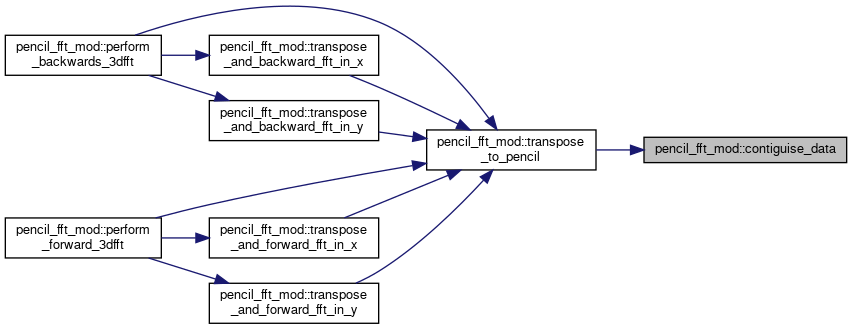
◆ convert_complex_to_real()
|
private |
Converts complex representation to its real data counterpart and is called after each forward FFT. After a r2c FFT, there are n/2+1 complex numbers - which means that there will be more real numbers in Fourier space than are provided into the forward FFT call (due to the extra +1). Note that the real size n will always be complex size * 2 This always unpacks the complex dimension in the first dimension.
- Parameters
-
complex_data Complex data in Z,Y,X orientation to be unpacked into its real representation real_data The real representation is written into here
Definition at line 704 of file pencilfft.F90.

◆ convert_real_to_complex()
|
private |
Converts reals into their complex representation, this is called for backwards FFTs as we need to feed in complex numbers to force FFTW to do a backwards. It is a relatively simple transformation, as n goes into n/2 complex numbers and as this is the result of the convert_complex_to_real procedure, n always divides evenly. This is always applied to the first dimension of the real data.
- Parameters
-
real_data The source real data to pack into the complex data, it is oriented Z,Y,X complex_data Target complex data which the real data is packaged into
Definition at line 726 of file pencilfft.F90.

◆ create_initial_transposition_description()
|
private |
Creates an initial transposition representation of the Z pencil that MONC is normally decomposed in. This is then fed into the create transposition procedure which will generate transpositions to other pencils.
- Parameters
-
current_state The current model state
Definition at line 613 of file pencilfft.F90.

◆ create_transposition()
|
private |
Creates a specific pencil transposition description. It is maybe more a decomposition description, but the main complexity comes from the transposition from existing decomposition to new decomposition so therefore it is called transposition. The new pencil decomposition depends not only on the dimension to split on, but also the existing pencil decomposition. The new decomposed dimension (i.e. the existing pencil dimension) * other local dimensions is used as the sending size, receiving though requires knowledge about the data size on the source process so others will send their pencil dimension size to this process.
- Parameters
-
new_pencil_dim The dimension to use as the new pencil decomposition existing_pencil_dim The dimension used in the current decomposition existing_pencil_process_layout Number of processes per dimension for the current decomposition existing_my_location The current processes block location per dimension for the current decomposition existing_pencil_size Pencil size per dimension for the current decomposition process_dim_sizes Sizes of the pencil dimension from other processes that is used to calculate receive count direction Whether we are transposing forwards or backwards, backwards is just an inverse extended_dimensions The dimensions that this process extends from n to (n/2+1)*2 (i.e. result of fft complex->real)
Definition at line 215 of file pencilfft.F90.
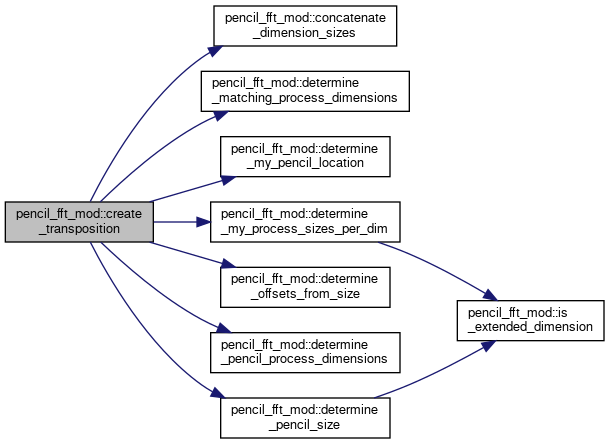

◆ deduce_my_global_start()
|
private |
Determines my global start coordinate in Fourier space. This is required for cos y and cos x calculation which is fed into the tridiagonal solver. After the forward FFTs, each process has ((n/2+1)/p+r) * 2 elements, where p is the number of processes and r is the uneven process remainder (1 or 0 depending on p). Therefore some processes will have t elements, and some t-2 elements to feed into the solver.
- Parameters
-
current_state The current model state dimension The dimension that we are calculating this for (Y or X)
- Returns
- My global start in Fourier space
Definition at line 751 of file pencilfft.F90.

◆ determine_matching_process_dimensions()
|
private |
Determines the sizes per dimension on the matching process either to receive from (forward transposition) or send to (backwards transposition) each source process. Not only does this depend on the my pencil sizes, but it also depends on the amount of data that the source process has to send over.
- Parameters
-
new_pencil_dim The dimension for the new pencil decomposition existing_pencil_dim Dimension for the existing pencil decomposition proc_sizes Size of dimension on the source processes (index in array corresponds to source PID) my_pencil_size My (new) pencil size per dimension pencil_processes_per_dim The process layout per dimension
Definition at line 592 of file pencilfft.F90.

◆ determine_my_pencil_location()
|
private |
Determines my location for each dimension in the new pencil decomposition. I.e. which block I am operating on.
- Parameters
-
new_pencil_dim New pencil decomposition dimension existing_pencil_dim Current pencil dimension existing_locations Location for the current decomposition
Definition at line 553 of file pencilfft.F90.

◆ determine_my_process_sizes_per_dim()
|
private |
Determines the number of elements to on my process per dimension which either need to be sent to (forwards transformation) or received from (backwards) each target process (in the row or column) This depends on the existing pencil decomposition, as effectively we are breaking that contigulity and decomposing it into n blocks in that dimension now (provided by new_pencil_procs_per_dim)
- Parameters
-
existing_pencil_dim The pencil dimension that we are transforming from existing_pencil_size Existing pencil decomposition sizes per dimension new_pencil_procs_per_dim For the target decomposition the number of processes per dimension global_grid Description of the global grid which we use for sizing information extended_dimensions List of dimensions where we extend from n to n+2 (i.e. result of FFT complex-> real transformation)
Definition at line 488 of file pencilfft.F90.


◆ determine_offsets_from_size()
|
private |
Simple helper function to deduce send or receive offsets from the sizes.
- Parameters
-
source_sizes Sizes that we are using to build the offsets
Definition at line 513 of file pencilfft.F90.

◆ determine_pencil_process_dimensions()
|
private |
Determines the number of processes in each dimension for the target decomposition. This depends heavily on the existing decomposition, as we basically contiguise our pencil dimension and decompose the existing pencil dimension. The third dimension remains unchanged.
- Parameters
-
new_pencil_dim New pencil dimension existing_pencil_dim Current decomposition pencil dimension existing_pencil_procs Current decomposition process layout
Definition at line 531 of file pencilfft.F90.

◆ determine_pencil_size()
|
private |
Deduces the size of my (local) pencil based upon the new decomposition. This depends heavily on the current pencil decomposition, the new pencil dimension is the global size, the existing pencil dimension becomes decomposed based on the number of processes in that dimension. The third dimension remains unchanged.
- Parameters
-
new_pencil_dim Dimension for the new pencil decomposition pencil_process_layout The processes per dimension layout for the new decomposition my_pencil_location My location in the block layout existing_pencil_dim Current decomposition dimension existing_pencil_size Current decomposition sizes global_grid Description of the global grid which we use for sizing information extended_dimensions List of dimensions where we extend from n to n+2 (i.e. result of FFT complex-> real transformation)
Definition at line 632 of file pencilfft.F90.


◆ finalise_pencil_fft()
| subroutine, public pencil_fft_mod::finalise_pencil_fft | ( | integer, intent(in) | monc_communicator | ) |
Cleans up allocated buffer memory.
Definition at line 92 of file pencilfft.F90.
◆ initialise_buffers()
|
private |
Initialises memory for the buffers used in the FFT.
Definition at line 152 of file pencilfft.F90.

◆ initialise_pencil_fft()
| integer function, dimension(3), public pencil_fft_mod::initialise_pencil_fft | ( | type(model_state_type), intent(inout) | current_state, |
| integer, intent(out) | my_y_start, | ||
| integer, intent(out) | my_x_start | ||
| ) |
Initialises the pencil FFT functionality, this will create the transposition structures needed.
- Parameters
-
current_state The current model state my_y_start My global start in fourier space for Y my_x_start My global start in fourier space for X
- Returns
- Size of local dimensions in fourier space for this process
Definition at line 51 of file pencilfft.F90.
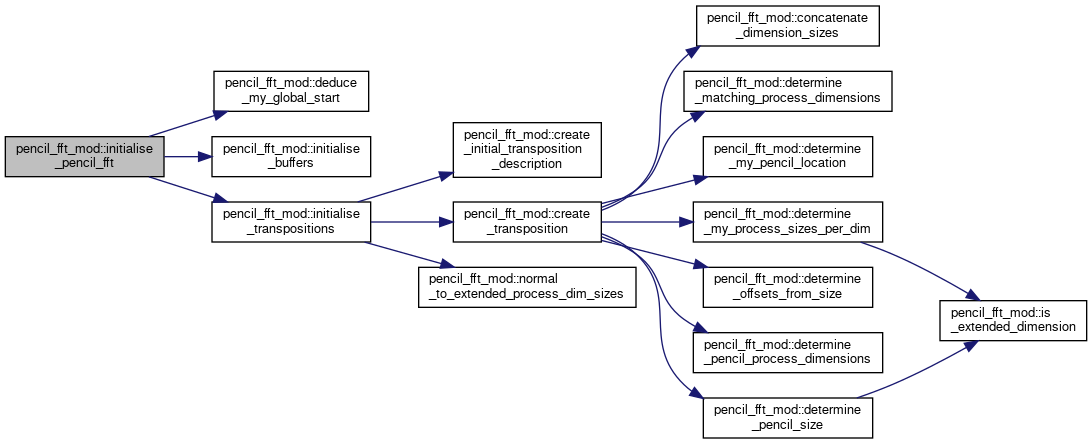
◆ initialise_transpositions()
|
private |
Initialises the pencil transpositions, from a pencil in one dimension to that in another.
- Parameters
-
current_state The current model state y_distinct_sizes Y sizes per process x_distinct_sizes X sizes per process
Definition at line 173 of file pencilfft.F90.
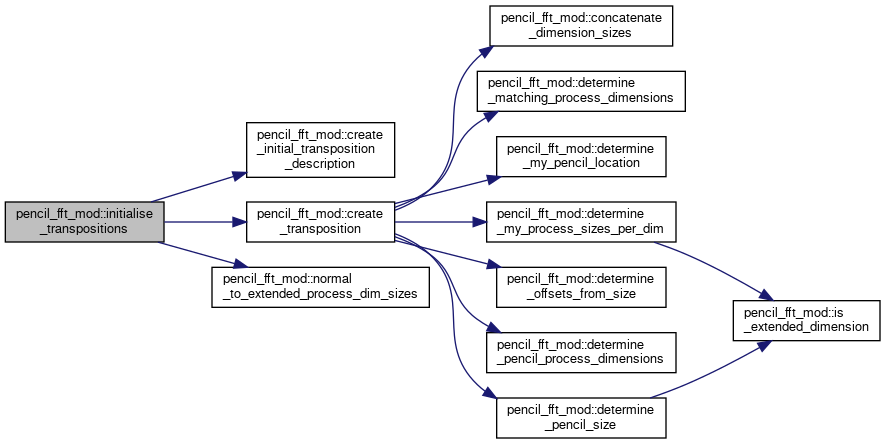

◆ is_extended_dimension()
|
private |
Determines whether or not the specific dimension is in the list of extended dimensions.
- Parameters
-
dimension The dimension to test for extended_dimensions Array of dimensions that will be searched
- Returns
- Whether the dimension is found in the array
Definition at line 667 of file pencilfft.F90.

◆ normal_to_extended_process_dim_sizes()
|
private |
Transforms real process dimension sizes into their real after FFT complex->real transformation. The way this works is that it goes from n to (n/2+1)*2 numbers which is distributed amongst the processes deterministically.
- Parameters
-
process_dim_sizes Real process dimension sizes
- Returns
- The extended process dimension sizes
Definition at line 684 of file pencilfft.F90.

◆ perform_backwards_3dfft()
| subroutine, public pencil_fft_mod::perform_backwards_3dfft | ( | type(model_state_type), intent(inout), target | current_state, |
| real(kind=default_precision), dimension(:,:,:), intent(in) | source_data, | ||
| real(kind=default_precision), dimension(:,:,:), intent(out) | target_data | ||
| ) |
Performs a backwards 3D FFT and currently results in target data which is the X, Z, Y oriented pencil Note that the source_data here takes no account for the halo, it is up to caller to exclude this. This does no FFT in Z, but transposes to Y, does FFT in Y, then transposes to X and performs an FFT in that dimension. Pencil decomposition is used which has already been set up.
- Parameters
-
current_state The current model state source_data The source real data to in the frequency domain target_data Time domain complex representation of the frequency domain source
Definition at line 137 of file pencilfft.F90.

◆ perform_c2r_fft()
|
private |
Performs the complex to real (backwards) FFT.
- Parameters
-
source_data Source (complex) data in the frequency domain transformed_data Resulting real data in the time domain row_size Number of elements for each FFT num_rows The number of FFTs to perform on the next data elements in the source_data plan_id Id number of the plan that tracks whether we need to create it or can reuse the existing one
Definition at line 449 of file pencilfft.F90.

◆ perform_forward_3dfft()
| subroutine, public pencil_fft_mod::perform_forward_3dfft | ( | type(model_state_type), intent(inout), target | current_state, |
| real(kind=default_precision), dimension(:,:,:), intent(inout) | source_data, | ||
| real(kind=default_precision), dimension(:,:,:), intent(out) | target_data | ||
| ) |
Performs a forward 3D FFT and currently results in target data which is the X, Z, Y oriented pencil Note that the source_data here takes no account for the halo, it is up to caller to exclude this. This does no FFT in Z, but transposes to Y, does FFT in Y, then transposes to X and performs an FFT in that dimension. Pencil decomposition is used which has already been set up.
- Parameters
-
current_state The current model state source_data The source real data to in the time domain target_data Frequency domain real representation of the time domain source which is allocated here
Definition at line 114 of file pencilfft.F90.

◆ perform_r2c_fft()
|
private |
Actually performs a forward real to complex FFT.
- Parameters
-
source_data Source (real) data in the time domain transformed_data Resulting complex data in the frequency domain row_size Number of elements for each FFT num_rows The number of FFTs to perform on the next data elements in the source_data plan_id Id number of the plan that tracks whether we need to create it or can reuse the existing one
Definition at line 430 of file pencilfft.F90.

◆ rearrange_data_for_sending()
|
private |
Rearranges data for sending, transposing a,b,c into c,b,a . This is done as alltoall splits on dimension c so to go from one pencil to another we assume here that a is the existing pencil as it is contiguous.
- Parameters
-
real_source Source data to transpose from real_target Target data to transpose to
Definition at line 468 of file pencilfft.F90.
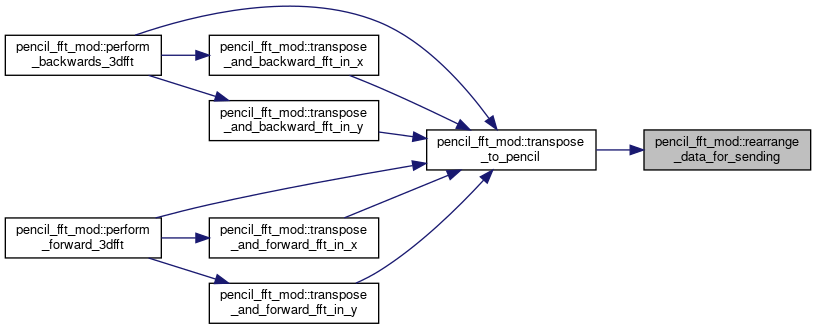
◆ transpose_and_backward_fft_in_x()
|
private |
Performs the backwards FFT in X and then transposes to Y pencil. The FFT requires complex numbers which are converted to real, so the this real to complex operation is performed first. If n is the logical size of the FFT row, then the input size is n+2, complex number size is n/2+1 and we get n reals out.
- Parameters
-
current_state The current model state source_data Input buffer, X pencil oriented x,z,y buffer Complex buffer which is fed into the FFT real_buffer Output buffer, Y pencil, oriented y,x,z
Definition at line 288 of file pencilfft.F90.


◆ transpose_and_backward_fft_in_y()
|
private |
Performs the backwards FFT in Y and then transposes to Z pencil. The FFT requires complex numbers which are converted to real, so the this real to complex operation is performed first. If n is the logical size of the FFT row, then the input size is n+2, complex number size is n/2+1 and we get n reals out.
- Parameters
-
current_state The current model state source_data Input buffer, Y pencil oriented y,x,z buffer Complex buffer which is fed into the FFT real_buffer Output buffer, Z pencil, oriented z,y,x
Definition at line 331 of file pencilfft.F90.


◆ transpose_and_forward_fft_in_x()
|
private |
Performs the transposition and forward FFT in the x dimension. After the FFT the complex space is converted back into real numbers. The X size is (n/2+1)*2 due to this transformation.
- Parameters
-
current_state The current model state buffer1 Input buffer, Y pencil after the Y dimension FFT oriented y,x,z buffer Complex buffer which results from the FFT buffer2 Output buffer, X pencil after this X FFT, oriented x,z,y
Definition at line 309 of file pencilfft.F90.


◆ transpose_and_forward_fft_in_y()
|
private |
Performs the transposition and forward FFT in the y dimension then converts back to real numbers. The Y size is (n/2+1)*2 due to the complex to real transformation after the FFT.
- Parameters
-
current_state The current model state source_data Input buffer, Z pencil oriented z,y,x buffer Complex buffer which the FFT writes into real_buffer Output buffer, Y pencil, oriented y,x,z
Definition at line 266 of file pencilfft.F90.


◆ transpose_to_pencil()
|
private |
Transposes globally to a new pencil decomposition. This goes from the source dimensions a,b,c to b,c,a (forwards) or c,a,b (backwards.) It requires multiple steps, first the local data is transposed to c,b,a regardless of direction. then it is communicated via alltoall, each process then assembles its own b,c,a or c,a,b data via contiguising across blocks as the data layout is nonlinear.
- Parameters
-
transposition_description Description of the transposition source_dims Dimensions of the current pencil that we wish to transpose from, will go from abc to bca communicator The MPI communicator associated with the group of processes who will swap data direction Whether this is going forwards or backwards, it makes a difference to the data arrangement source_data Source data (abc) target_data Target data (bca)
Definition at line 357 of file pencilfft.F90.

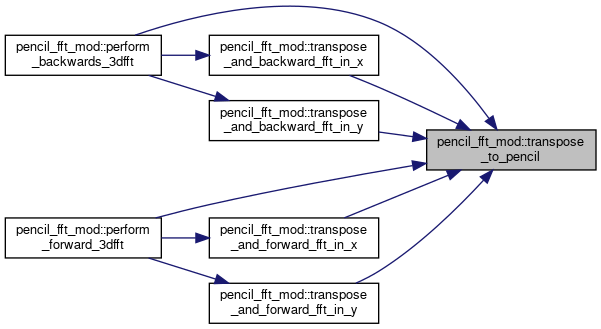
Variable Documentation
◆ backward
|
private |
Transposition directions.
Definition at line 28 of file pencilfft.F90.
◆ buffer1
|
private |
Definition at line 37 of file pencilfft.F90.
◆ buffer2
|
private |
Definition at line 37 of file pencilfft.F90.
◆ dim_x_comm
|
private |
Communicators for each dimension.
Definition at line 29 of file pencilfft.F90.
◆ dim_y_comm
|
private |
Definition at line 29 of file pencilfft.F90.
◆ fft_in_x_buffer
|
private |
Definition at line 35 of file pencilfft.F90.
◆ fft_in_y_buffer
|
private |
Definition at line 35 of file pencilfft.F90.
◆ fftw_plan
|
private |
Definition at line 40 of file pencilfft.F90.
◆ fftw_plan_initialised
|
private |
Definition at line 41 of file pencilfft.F90.
◆ forward
|
private |
Definition at line 28 of file pencilfft.F90.
◆ real_buffer1
|
private |
Definition at line 35 of file pencilfft.F90.
◆ real_buffer2
|
private |
Definition at line 35 of file pencilfft.F90.
◆ real_buffer3
|
private |
Definition at line 35 of file pencilfft.F90.
◆ x_from_y_2_transposition
|
private |
Definition at line 31 of file pencilfft.F90.
◆ x_from_y_transposition
|
private |
Definition at line 31 of file pencilfft.F90.
◆ y_from_x_2_transposition
|
private |
Definition at line 31 of file pencilfft.F90.
◆ y_from_x_transposition
|
private |
Definition at line 31 of file pencilfft.F90.
◆ y_from_z_2_transposition
|
private |
Definition at line 31 of file pencilfft.F90.
◆ y_from_z_transposition
|
private |
Definition at line 31 of file pencilfft.F90.
◆ z_from_y_2_transposition
|
private |
Definition at line 31 of file pencilfft.F90.
◆ z_from_y_transposition
|
private |
Definition at line 31 of file pencilfft.F90.